The Yogadrishti (Yogavision) series of satsangs consists of discourses given by Swami Niranjanananda Saraswati in Munger as part of the new phase of sannyasa life that he has embarked upon since 2009.
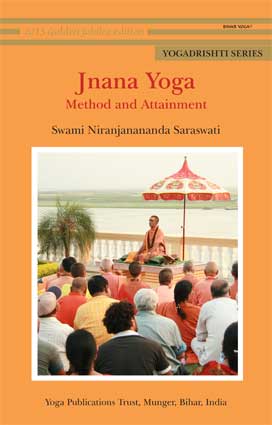
Method and Attainment
Swami Niranjanananda Saraswati
“The method of understanding the process of jnana yoga has to be understood properly. Is jnana only questioning? No. It is enlarging the scope of perception. It is not enquiry. It is like working with an adjustable torchlight. You can twist its head to bring the light to a narrow point or enlarge its perimeter.”
Jnana yoga was the theme of the satsangs which Swamiji gave in May 2011 at Ganga Darshan Vishwa Yogapeeth. Providing a fresh, new perspective on the classical components of jnana yoga, Swamiji renders this complicated subject accessible. He outlines the step-by-step training necessary to attain the aims of jnana yoga and describes how the profound statements of the Vedas, the mahavakyas, unfold naturally in the process. The discourses shine with spiritual inspiration and practical guidance in the method of applying intelligence and developing true wisdom in life.
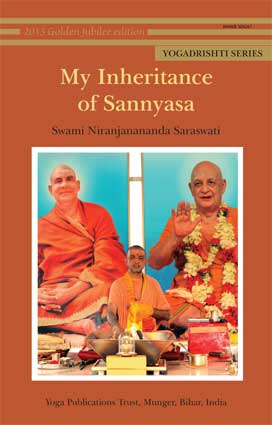
Swami Niranjanananda Saraswati
“An institution is not an inheritance. Buildings and wealth are not the inheritance of a sadhu. A sadhu’s wealth and assets are the qualities he lives with lifelong. It is a disciple’s duty to strengthen the ideals that he upholds, lives and conducts himself with every day of his life. This is sannyasa. People think of sannyasa as renunciation, but sannyasa is connection; connection with oneself, one’s mind, spirit and creativity, with knowledge and dispassion, and with a philosophy which guides every step of life.”
The theme of the satsangs Swamiji gave in July 2012, during Guru Poornima celebrations at Paduka Darshan Sannyasa Peeth, was the tradition of sannyasa that he has inherited and is passing on. Swamiji spoke on the origins and development of the sannyasa parampara, describing the lives, inspirations and teachings of eminent sages and gurus from ancient times, including Dattatreya, Adi Shankaracharya, Swami Sivananda and Swami Satyananda, who were major forces in preserving, continuing and developing the spiritual current of India. Through describing these great personalities, Swamiji elucidated on the essence of the guru tattwa.

Swami Niranjanananda Saraswati
“The application of the teachings of Sage Vasishtha made Sri Rama an idol and a hero, and he continues to be the inspiration for all people in the Indian subcontinent and beyond. Not because he is God, not because he is considered to be an avatara, but because he became the perfect human being. This is the message of Yoga Vasishtha: how to become the best person that you can be, your perfect self, and apply the principles of Sage Vasishtha in your life.”
The yoga of Sage Vasishtha was the theme of the satsangs Swamiji gave in March 2012 at Ganga Darshan Vishwa Yogapeeth. The Yoga Vasishtha is a treatise in which Rishi Vasishtha instructs Sri Rama on how to overcome his depression and actively engage in the world while remaining unaffected by it. Selecting the key discussions, Swamiji explains how this ancient work provides fresh motivation and positivity to manage the challenges of daily life, while cultivating deep spiritual wisdom and perfection in action. He deals with the subject in a clear, step-by-step manner, making it easy to comprehend and applicable to the lives of all.
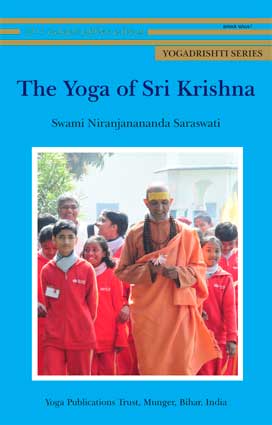
Swami Niranjanananda Saraswati
“The Bhagavad Gita is not a religious book or a treatise on philosophy. It is a work which dispels doubts about the dharma that one has to live in life. According to the founding thoughts of the Bhagavad Gita, the process of managing life and the cultivation of better qualities, dharma and the journey of life are the focus of an individual. Yoga is the medium through which one is able to complete this journey.”
The yoga of Sri Krishna was the theme of the satsangs Swamiji gave in February 2012 at Ganga Darshan Vishwa Yogapeeth and Paduka Darshan Sannyasa Peeth. Swamiji elucidates the yogic practices that Sri Krishna taught Arjuna on the battlefield. He explains how these simple practices cultivate understanding and awareness, and are methods of managing the different situations one encounters daily. Swamiji provides a fresh, new perspective on the understanding of the Bhagavad Gita, as he enumerates the yogic sadhanas that lie hidden within the text and offers practical steps for the development of courage, peace and focus in negotiating life’s challenges.
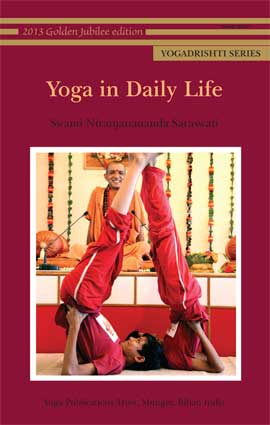
Swami Niranjanananda Saraswati
“I do not consider yoga as just a practice; rather, in ‘Niranjanananda Yoga Samhita’, yoga is grouped into four categories: practice, sadhana, lifestyle and culture. This is how I see yoga. I see yoga as a practice, I see yoga as a sadhana, I see yoga as a lifestyle and I see yoga as a culture. This is the progression of yoga.”
The theme of the satsangs Swamiji gave in August 2011 at Ganga Darshan Vishwa Yogapeeth was yoga in daily life. Swamiji spoke on the purpose of yoga in one’s life and the practical integration of the various systems for body, mind and spirit. He gave a detailed description of the yoga capsules that everyone can include in their daily life. Swamiji elucidated the spiritual sciences and traditions in a classical and deep yet light manner, bringing to life the insight and wisdom of the ancient seers and scriptures.
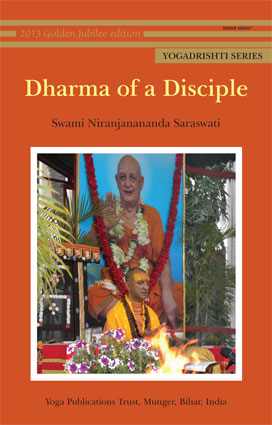
Swami Niranjanananda Saraswati
“A disciple is the transmitter of the guruís shakti. For shakti to be transmitted, the wire has to be carbon-free. If there is accumulation of carbon in the wires that carry electricity from one bulb to another, the lights will not come on. Therefore, the aim of discipleship is to remove the accumulated carbon from our wires and ensure that they are always clean so that the current of divine grace can flow continuously and constantly, and that is the dharma of a disciple.”
The dharma of a disciple was the theme of satsangs given in August 2010 at Ganga Darshan, after Swamiji returned from Guru Poornima celebrations at Rikhiapeeth. Beginning with insightful reflections on the guru tattwa, Swamiji leads us to assess where we stand as a disciple, our character and its strengths and weaknesses, and how we can move up from where we are by fortifying our base and acquiring the necessary attributes. The satsangs answer a fundamental spiritual question: what is the highest truth that an adherent of the guru-disciple tradition must live by.
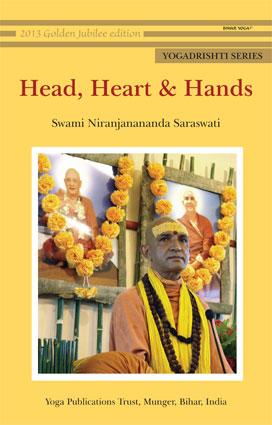
Swami Niranjanananda Saraswati
“Awakening the faculties of head, heart and hands means that you have to develop and discover a better you. The possibility of becoming better is already in you. If you can remain optimistic, positive and creative, balanced in emotions and thoughts, then a new you emerges from the ashes of the old you. That new you is the yogi you. This is the yogic journey that Swami Sivananda spoke about, and this is the yogic journey that Swami Satyananda has started us on.”
The yoga of head, heart and hands was the theme of the satsangs Swamiji gave in October 2010 at Ganga Darshan. Swamiji explained how an integral development can come about while a harmonious state of mind and emotions is created. The aspirant needs to understand the essential nature of these faculties and follow a sequential path for their transformation, along with acquiring a new perspective on performance.

Swami Niranjanananda Saraswati
“Karma is manifestation of human nature. It is something which is expressed spontaneously, naturally and unconditionally, because this entire creation is nothing but manifestation of karma. The entire creation, the entire universe, the entire life is manifestation of karma, and the seed of karma in creation was planted by the cosmic will.”
Karma and karma yoga was the theme of the satsangs given in February 2010. The illuminating and in-depth discourses provide a fresh perspective on this timeless subject and also a clear map for the course of our life. The satsangs are one of the finest examples of Swami Niranjan’s inimitable style: light yet deep, refreshing yet classical, profound yet practical.
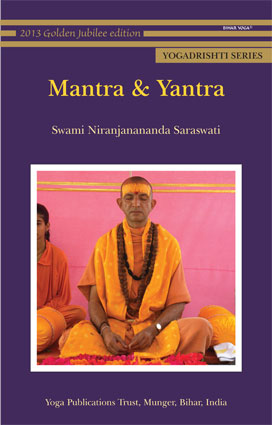
Swami Niranjanananda Saraswati
“Mantra and yantra constitute the instruments, mediums or methods by which one can explore and realize energy patterns and awaken the dormant centres of consciousness. Mantras and yantras are not only a combination of sounds and visual images used in meditation, but represent the first subtle manifestation of the two cosmic powers of consciousness and energy, as mantra and yantra.”
Mantra and yantra was the theme of the satsangs in March 2010 during Chaitra Navaratri. Here, Swami Niranjan traces the origin and nature of mantra and yantra and how they act as a link between the individual and the cosmos. These satsangs introduce both the theoretical and practical aspects of a vast subject, providing aspirants with an understanding of mantra and yantra as tools for sadhana.
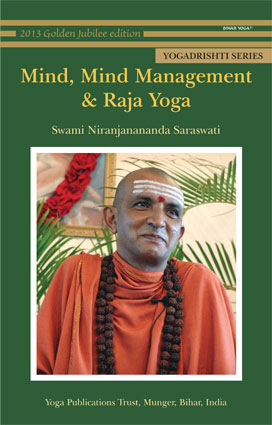
Swami Niranjanananda Saraswati
“The highest sadhana in life is mind management, not meditation. The highest awareness is how the mind responds to different situations. Sadhana is not an abstract idea; it is a practicable, step by step method. This is the approach that the yogis and seers have adopted in order to harness the potential of the mind.”
Mind, mind management and raja yoga were the theme of the satsangs Swamiji gave in April and May 2010 at Ganga Darshan. In these illuminating discourses, Swamiji puts the vast experience of the mind into easily comprehensible capsules. He approaches the subject from the classical, psychological as well as practical points of view, providing guidelines on managing the various expressions and experiences of the mind. These satsangs are a fine example of the depth and range of Swamiji’s vision and understanding.
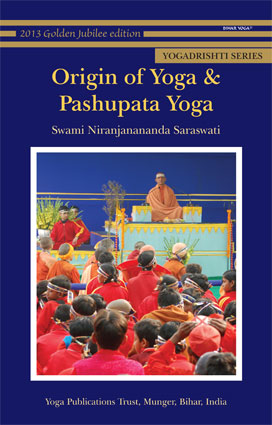
Swami Niranjanananda Saraswati
“The first yoga propounded by Shiva was known as Pashupata yoga. Not hatha yoga, not raja yoga, not kundalini yoga, not karma yoga, not bhakti yoga. The original name describes the aim of yoga. Pashu means animal and pati means master. Therefore, it is the yoga in which one becomes aware of the relationship between oneís self and the divine in the form of slave and master. Shiva taught the methods by which a human being can be freed from suffering and attain Shivahood, the state of spiritual awakening.”
The first Satsang Series was held in January 2010 at Ganga Darshan. Swamiji spoke on the origins of yoga and the first philosophy and system of yoga, called Pashupata yoga. The theme was carried over to the February satsangs held at Baidyanatheshwar Shankarbagh (Sivalaya) in Munger. Describing a dialogue between Shiva and Parvati from which emerged Pashupata yoga, Swamiji speaks of the eternal search for happiness, the classical understanding of suffering, yoga as a science of life, sequential systems of sadhana and the final state of transcendence.
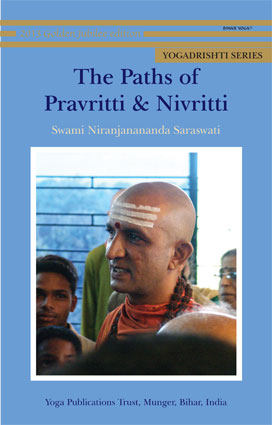
Swami Niranjanananda Saraswati
“Once there was a traveller who had been travelling for a long time and had not yet reached his destination. The destined place was far away. The traveller was traversing through ages, times and aeons, trying to reach the end of his journey. The destination was Brahmapuri, City of Light, and the name of the traveller was Mr. Atmaram, meaning Mr Soul…”
The paths of pravritti (intense attachment to the world) and nivritti (disassociation from the material world) were the theme of the satsangs Swamiji gave in June 2010 at Ganga Darshan, after returning from a period of meditation and contemplation in the high Himalayas. Swamiji introduces the theme with a metaphorical tale of ‘Atmaram’ and his journey to the ‘City of Light’. Fundamental questions are answered: the basis and method of living harmoniously while following a material life, the point at which an aspirant moves on to the spiritual path, and the role of a guide on the journey.
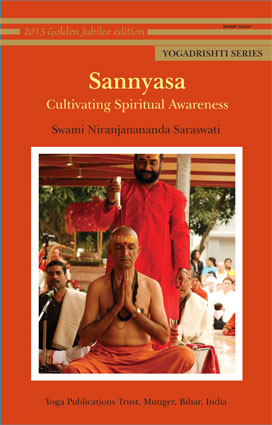
Swami Niranjanananda Saraswati
“Sannyasa is not initiation, sannyasa is not renunciation, but cultivation of the right samskaras so that one may live a life of dharma.”
Sannyasa was the theme of the satsangs Swamiji gave in January 2011 at Ganga Darshan, after returning from the programs held for the first anniversary of Sri Swami Satyananda’s Mahasamadhi at Rikhiapeeth.
Illustrating the ideals of sannyasa through Sri Swami Satyananda’s life, Swamiji takes us on a journey to the origins, traditions and essence of this path, and provides a sequential approach by which it can become a practicable lifestyle. The satsangs culminate with a glimpse into the mandate and aspirations of Sannyasa Peeth.
